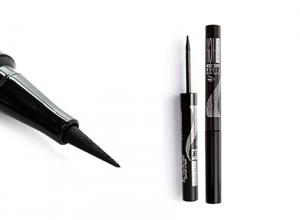My Master Classes: sewing a lock into a knitted blouse.
HOW TO SEW A ZIPPER BEAUTIFULLY INTO A KNITTED PRODUCT
Master Class
In order for the zipper in a knitted fabric to look neat, not to “fade” or, conversely, not to pull the edges together, but to “stand” evenly in the cutout of the fastener or on the floors, first be sure to wet-process the finished product. I always wash a knitted item and dry it on a flat horizontal surface, or in some cases hang it on hangers so that the parts are stretched (this depends on the characteristics of the yarn used) to avoid the risk of stretching during further use.
So, the product is ready and dried, we sew in the zipper as follows:
- Pin each textile part of the zipper to the edge of the corresponding shelf
2. Use a needle to sew along the textile part of the zipper on the front side of the product using a “machine” seam (= “back needle stitch”)


Option 1.
This is the most rational method for fasteners that use a permanent zipper. For example, a polo collar with a zipper, a zipper in children's overalls, skirts, etc.
3.1.1. To decorate the wrong side of the product, it is necessary to sew along the edge of the textile part of the zipper with a needle an “overlocking” seam - this will additionally fix the sewn zipper and partially “close” the fastener, “veiling” the free segment up to the snake.

3.1.2. On the front side of the product, tie the edges of the fastener with a crochet hook or pattern *1 VP, 1 connector. in every chrome. P.*






Option 2.
The method of processing the edge of the fastener from the wrong side in products with a detachable zipper, i.e. if there are product shelves. This method is suitable if the underside is visible when the floors are unbuttoned and where a more “closed” option is required - an analogue of braid on top of the textile part of the zipper.
In this case, you can do this:
3.2. 1. From the seam formed by sewing (“machine” seam - step 2), crocheting out the loops from under the stitches On the wrong side of the product, use the main working yarn to knit 1 row of sc.

and 1-2 rows of DC depending on the thickness of the yarn (= binding for a width of approx. 1.5-2 cm).

Sew on the resulting “inner” trim with a needle, tucking it inside the edges of the zipper.


On the outside of the product, crochet the edges of the zipper 1 row with a pattern *1 VP, 1 connect. Art. in each next edge st.*



Or you can tie the front part, for example, with a hollow i-cord cord



VideoMK -
I hope that you find these ways to beautifully design a zipper in a knitted product useful. Try it!
Knit with pleasure!
Views: 312
Today we will show you a fairly simple method of sewing a zipper into a knitted garment. What will be used here is not a hook, but a sewing needle. This method seems easier to many. If you've knitted a sweater but can't get to the zipper, you can use this method. Everything should definitely work out for you!
Sewing a zipper into a knitted sweater
For work we use the following tools and accessories:
- zipper
- pins
- thin knitting needles – 4 pcs.
- hand needle
- threads to match the color of the sweater material
Operating procedure
Please note that the jacket (or other knitted product) must be completely prepared, as well as steamed and dried.

Step 1. First, string the edges to which we will sew the zipper onto knitting needles. We do this with a certain rhythm, repeating the knitting pattern. Look carefully at the drawing to see how this is done.

Step 2. Pin the first side of the zipper and sew it along the edge with a needle back stitch. We grab one knitting thread at a time, with the same rhythm. As you work, check the quality of the sewing by moving the zipper slider. If it mixes freely and does not pinch the edge, then everything is fine.



Step 3. If everything turned out well, sew the second edge of the zipper with a needle stitch back.

Step 4. Pin the other side of the zipper. Lay out the jacket on the table and check that the zipper is connected to it correctly. The jacket should lie flat on the plane, there should be no slightest distortion.

Step 5. Sew the second side of the zipper in two lines, in exactly the same sequence as the first.
Step 6. Remove all knitting needles, pins and needles when finished. We carefully check the quality of the seams and the work of the zipper.
Step 7. Lightly steam the clasp and dry it.
That's it, the product is completely ready! A cute and comfortable knitted sweater to wear.
How to sew a zipper into a knitted sweater Detachable shelves with a zipper give the jacket a modern look and make it more comfortable to wear. Using this simple but practical fastener, you can create a high stand-up collar that will be easy to put on your head and at the same time fit your neck well. To make a jacket with a zipper look neat from the front and back sides, it is recommended to use a double strip for sewing it in. Another knitting option is the so-called hollow elastic band. You will need - two straight knitting needles; - tailor's meter; - yarn; - cotton threads to match the sweater; - contrasting threads; - needle; - sewing machine; - scissors for removing basting; - zipper along the height of the shelf. When patterning a sweater, immediately accurately calculate the width of the right and left shelves in order to leave room for a knitted placket for sewing in a zipper. When calculating the cutting elements, do not forget that between the future slats there should be room for metal or plastic teeth and free movement of the slider. Of course, a zipper of a suitable size should be prepared in advance. Before making the zipper placket, be sure to knit a sample with stockinette stitch 10 cm long. Measure the distance from the bottom of the jacket to the top edge of the collar - this is the length of the future placket. Accurate calculations will help you correctly cast on the loops along the edges of the product. Turn the work over and from the wrong side of the sweater, cast on loops for the bottom layer of the bar. Knit it using the front piece as a sample. Close the last loops. Similarly, make a double plank from the right edge of the shelf. All details must be worked absolutely symmetrically! The placket should neither tighten the hem of the jacket nor gather it into unattractive gathers. Unfasten the zipper and insert its halves into the double placket. Baste the fastener fabric with a thread of a contrasting color from bottom to top. Open and close the basted zipper - if it fits correctly, you can sew the zipper to the jacket white with threads that match the jacket and fastener. This can be done manually with a hidden seam or machine stitched. Carefully remove the basting with nail scissors. A worthy alternative to a double bar is a hollow elastic band. It is no less convenient for sewing a zipper on a knitted product. For the elastic, calculate the required number of cast-on loops based on the pattern of the front stitch. Multiply the resulting number by 2. For example: if 15 loops are placed in a knitted pattern 10 cm long, then for a hollow elastic band of the same length you should cast on only 30 loops. In the first row of hollow elastic, do the following alternations: 1 knit stitch; The next loop is removed unknitted. In this case, the working thread must be in front of the loop! In the second and subsequent rows of hollow elastic, the removed loops must be knitted. The loops knitted in the previous row, on the contrary, are removed unknitted. Follow the pattern until you reach the desired width. Start sewing the zipper to the jacket from the bottom of the work. Gradually release small sections of the hollow elastic from the knitting needle. Insert the corresponding section of the fastener into the opened part of the strap. Sew open loops: the needle should pass through the front open loop through the zipper fabric and exit through the open loop on the wrong side of the product. Continue working until you have sewn the entire zipper. This way, you will carefully close the open edge of the hollow elastic and at the same time sew the zipper to the placket. All you have to do is make the final connecting stitch on your sewing machine.
As you know, knitting is not just one of the many types of needlework, but also a very practical way to update your wardrobe. But, as in any other business, some difficulties may arise here. One of them is the problem of how to sew a high-quality zipper quickly and easily into a knitted product.
So, let's say that you knitted a beautiful thing and bought a zipper that matches it in color and size. All that remains is to sew it into a knitted sweater. First of all, it is worth preparing the edge strips. In this matter, everything depends on the model of your sweater and its pattern.
In our example, the central part of the front is predominantly knitted with stockinette stitch, and as you probably know, its edges are curled. Therefore, it is imperative to strengthen these edges with narrow strips.
How to sew a zipper into a knitted product with your own hands in MK
In this case, the strips are made with double elastic. To ensure that the elastic does not tighten the fabric too much, you need to follow the advice outlined below:
- Since the edges on the fronts in our example were knitted, so to speak, classically (the first loop is removed, and the last one is made purl), the edge eventually took the form of a chain. From this chain, we then collect loops for the strap along the front side (with two stitches along the way from each edge). In this case, the first loop must be knitted under both walls of this loop, and the second - only under the front wall.
- We move to the next row (on the wrong side) and begin to knit a double elastic band (in this case, you need to alternate one front one, remove one loop unknitted). We knit four rows in this way.
- In the fifth row we close the loops, also alternating: two loops - like an elastic band 1?1, and we knit the next four loops two together using the front method of broaching (that is, first remove the front loop, then remove the loop removed in the previous row and knit purl, after which pull through the removed front). If you close the loops on the bar this way, its edge will never be stretched.
So, when both planks are prepared, we lay out our product somewhere on a flat surface. You need to very carefully straighten and align the future blouse along the seams and sides. The planks need to be aligned exactly end to end.
To prevent them from moving apart in the future when sewing in a zipper, you need to sew them, connecting them with oblique stitches. At the same time, we make sure that the edges remain end-to-end.

Next, turn the blouse inside out. From the inside out, we apply our zipper in the closed state, set it as evenly as possible: so that the central axis running along the teeth falls exactly at the junction of our strips. You can use a couple of pins to secure it.
Now we gradually baste the zipper with oblique stitches, starting from the bottom. Having reached the top, we adjust the final height of the zipper. If necessary, trim it.

So we did it. Now it's time to sew on the zipper. This is often done by hand, since it is unknown how the knitted fabric will behave under the foot of a sewing machine.
The fastener should also be sewn on the wrong side of the work, starting from the bottom. In this case, the threads need to be matched as closely as possible. We try to make a beautiful and even seam. Moreover, the “main beauty” should shine on the zipper strap, but on the front side of the product, the stitches should be small and almost invisible.
Once you get to the top, a closed slider may prevent you from sewing further. To do this, you can lightly undercut the stitch and lower the slider down a little to calmly sew it to the end. Thus, without haste, we sew the zipper on both sides.
A little advice: if you have a double collar (as in our example), you will need to additionally hem the edge of the collar to the neckline, and its side edges will need to be hemmed to the zipper itself. There you go!

How can you properly sew a zipper into a knitted bag?
Fashionistas and needlewomen love to create not only blouses, dresses or tops, but also many other little things, so to speak, for themselves. Therefore, let’s take a closer look at how to sew a zipper into a knitted bag.
To work, you will need to buy a clasp that matches the color and size of your future handbag. Now take a crochet hook and make two strips that will match the length and width of the zipper. The color of the yarn for the straps should be the same as the yarn of the bag.
Next, sew a fastener to the connected strips. Please note that the tied posts should lie on top of the tape on which the zipper is attached. Now the resulting structure must be connected to the lining. To make the work go faster, do not sew up the entire lining, but leave a small hole that allows you to carefully sew the fastener from the inside out.
Once the work is done, you can sew the lining with a clasp to your bag using simple stitches. You will find more detailed and visual instructions about this in the video below the article. All the best!
Video on the topic of the article
Now sewing a zipper into any knitted product will not be a problem or obstacle for you, and in order to further facilitate your creative process, we offer you a selection of thematic videos.
Latest site materials
Horoscope

Flawless autumn: new makeup collection from Guerlain GLOWING GARDENS FROM DIOR
Autumn is already very close and soon you will have to say goodbye to summer beauty products and take a closer look at the new products on the beauty market. Therefore, we invite you to get acquainted with the most beautiful makeup collections for the coming season right now. Autumn collection
Health

Enhance your eye beauty with eyeliner
We choose the right solution for what to do if your eyeliner has dried out. Many girls have experienced that their new eyeliner or mascara has dried out after a couple of uses. Dry cosmetics lose their properties, crumble, form lumps and fade
Experience

Perfume application technique
Whether it's Chanel No. 5, which a naked Marilyn Monroe "dressed" before going to bed, or your scent, which is smelled every morning in the elevator by subordinates, there is one thing that unites us all: the desire to smell for as long as possible. Ivan Bezugliy ra
Health

The most interesting questions about electrolysis
Electrolysis is based on the properties of electric current, which can negatively affect the hair roots. Electrical energy is directed to the area of direct hair growth. Modern devices allow you to act directionally, accurately and without
Cooking

How to do a vacuum anti-cellulite massage
Cupping massage for cellulite at home is an effective alternative to expensive salon procedures that does not require a lot of time, money or special skills of a massage therapist. In order not to waste money and time in beauty salons, you can fight cellulite at home.
Horoscope

How to make a paper butterfly with your own hands
Summary: Craft butterfly. DIY paper butterflies. How to make a butterfly out of paper. Origami butterfly diagram. Butterflies master class. Butterfly pattern. How to make a butterfly from a plastic bottle. Crafts from plastic bottles. In the spring, as soon as